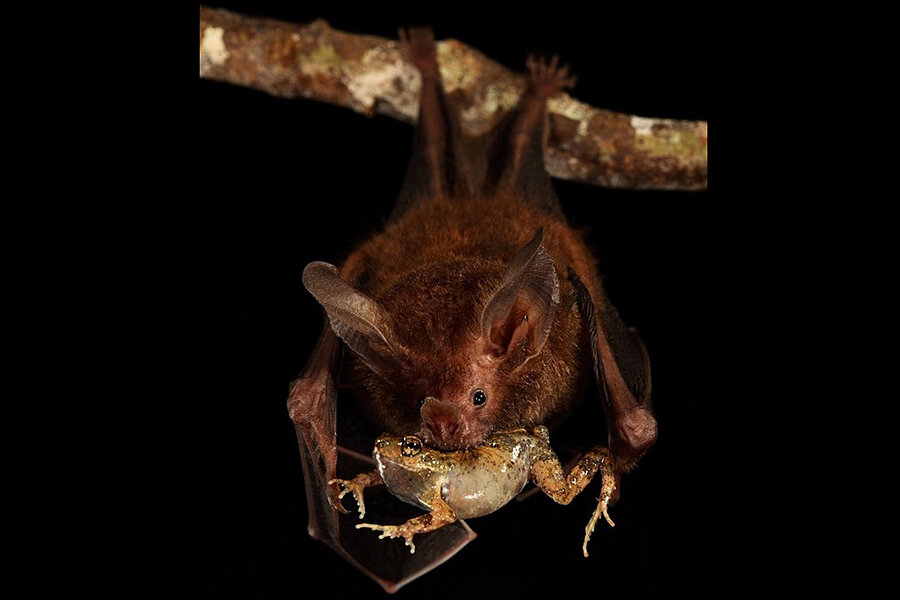How a frog's mating call invites death from above
Loading...
Male túngara frogs croak from shallow puddles to attract mates. But new research finds that their love songs have a dark side: They create ripples that attract the attention of frog-eating bats.
And while these frogs can clam up when they sense a bat fluttering nearby, and avoid becoming a meal, they can't stop the ripples created by their serenade. The finding reveals that it's not only the sound of an animal's communication, but also the lingering "footprint" that communication leaves on the environment that can be sensed by others, according to the paper published today (Jan. 23) in the journal Science.
"Animals have all kinds of sensory systems that they can use in very different ways, and they can combine their senses," said study leader Wouter Halfwerk, a postdoctoral researcher at the University of Texas, Austin.
The study shows not only "very complex interactions between individuals of the same species, but also between individuals of other species like predators and prey," said Halfwerk, who conducted the research while at the University of Leiden in the Netherlands and the Smithsonian Tropical Research Institute in Panama.
'Crazy' for ripples
The mottled-brown túngara frog (Physalaemus pustulosus) is found in Central and South America. Males issue their mating calls by inflating an air sac under their chins, producing both a loud croak and ripples in the water as their air sacs disturb their puddles. [See Video of the Croaking Frogs]
Halfwerk and his colleagues already knew that females prefer male frogs with both a big croak and a big air sac. In the new study, they looked at whether the ripples serve other communication purposes, too. First, they presented males with the sound of another male's croaks, or ripples from the croaks, or both at once.
"With sound, they responded a little bit by calling back, but as soon as you add ripples they go crazy," Halfwerk told LiveScience. "They double their call rates, they start moving around, looking for the potential intruder."
The frogs compete with other males that share their puddles, Halfwerk said, so the ripples may be a warning that rivals are very close. When the researchers put multiple frogs in one puddle at varying distances, they found that frogs close to one another respond to ripples and calls by either becoming aggressive, or shrinking into themselves, trying to avoid a fight.
Next, the researchers wondered if bats could also pick up on the ripples. They set up two trays of water, each with a model frog, sitting on a speaker. From one tray, they played the sound of a male mating call. From the other, they played the same call but added ripples.
The scene played out for the benefit of 10 captive bats (Trachops cirrhosus), each of which was brought to a perch nearby and allowed to hunt the fake frogs. Nine out of the 10 bats tested clearly preferred the rippling water, Halfwerk said. And the increase in attacks on that frog was "quite high," he added — 36 percent greater than the rate of attacks on the frog in the still puddle.
Risky ripples
The findings reveal that the ripples are easily "overheard" by bats, which sense the water motion through echolocation.
"Once they scan the surface, they get an enormous amount of information from these ripples," Halfwerk said.
Littering the puddles with leaves took away the bats' ability at sensing ripples, the researchers found, but frogs in the wild don't only call from protected, leaf-littered ponds.
"We definitely want to understand, OK, what makes these frogs still call from these very open locations?" Halfwerk said. "Might there be other selection pressures that drive this?"
Follow Stephanie Pappas on Twitter and Google+. Follow us @livescience, Facebook & Google+. Original article onLiveScience.
- Ewwww! Photos of Bat-Eating Spiders
- Gallery: Cute and Colorful Frogs
- Flying Mammals: Gallery of Spooky Bats
Copyright 2014 LiveScience, a TechMediaNetwork company. All rights reserved. This material may not be published, broadcast, rewritten or redistributed.







